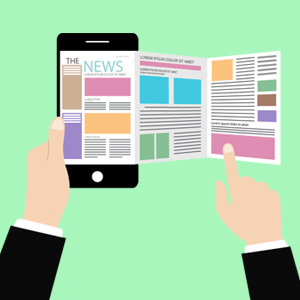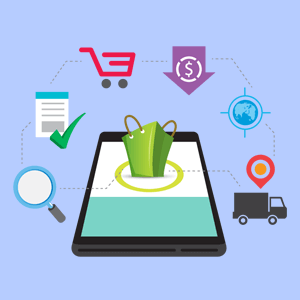Retailers are increasingly relying on mobile applications to improve customer relations, increase market penetration, and improve incremental sales. In fact, mobility is no longer optional for retailers, with eCommerce and mCommerce growing year over year. Such growth demands a sound and cohesive mobile app strategy to be deployed by retailers.
Mobility has become so essential that mobile retail applications account for much of the mCommerce explosion, with conversion rates resulting from mobile apps at 120% over mobile browser conversions. There’s more to it, however, than simply slapping your logo on an ecommerce tool and raking in the cash.
Companies are increasingly leveraging mobile app design by depending on the effectiveness of these 5 UI / UX practices to harness the true power of mobility.
1. Start with an effective visual flow

A properly designed mobile app’s interface has a visual flow that combines elements of the application’s architecture, content, and functionality and skips unnecessary visual elements. The design should guide users throughout the consumer experience as quickly and efficiently as possible.
In 2015, Virgin America Airlines won a Webby Award for the functionality of its mobile website redesign. The highlights of the site include reducing load times and maximizing the time it takes to book a flight – 2-second load time and 8 seconds to checkout. Through an effective mobile app development strategy, Virgin America eliminated meaningless images that slowed down the load time and integrated similar images into the site’s visual language, allowing users to easily identify visually where they are in the process of booking a flight.
2. Consider mobile display limitations into account

The limited space afforded by mobile devices is the biggest challenge design teams face in executing the UI / UX portion of a mobile app development strategy. With such space limitations in play, designers must work around these challenges in order to create effective user experiences. Proper design, spacing, and placement of control elements such as buttons are all issues then must be addressed in the development process.
For example, both the “Buy” and “Cancel” buttons in an e-commerce app must share screen space, and yet be placed far enough apart in the UI that they are easily differentiated and the chances of clicking the wrong button are minimized.
Similarly, navigation and menu design must be clear and easy to understand, as well as visually cohesive – color, visual elements, placement of UI components – with the mobile application’s design. The goal of such a mobile app design strategy for retailers is to maximize ease of use and minimize user mistakes or frustration that could lead to lost sales and lost repeat business.
3. Make the CTAs meaningful and actionable

One of the most useful tools in the mobile app designer’s arsenal is the “Call to Action,” or CTA. The designer’s ultimate goal of utilizing CTAs is to guide users to actionable areas of your app, such as adding items to a shopping cart, marking items as favorites, exploring item descriptions, finding related products, and reading reviews left by other users.
Why should you be making an effort to guide users to the actionable parts of your mobile application? Because mobile apps result in more conversions than mobile browsers. In 2015, the State of Mobile Commerce Report showed that apps resulted in a 286% increase in items viewed per user, an 85% increase in items added to the basket, and a purchase rate that is 23% more than mobile browsers.
4. Lead the audience to the end goal as quickly as possible

The most successful retailer applications use effective mobile app design strategies to guide users through the app experience with the integration of tools such as mobile wallets, the ability to create secure user accounts and save payment methods, ultimately guiding the reader to a payment page or a login screen, and to do all of these things in a very limited window of time. If your app design does not expedite this process, you run the risk of losing sales if visitors don’t convert their actions into sales.
Designers meet this challenge by ensuring CTAs are extremely targeted and streamlined and ultimately land users on a checkout screen with their finger poised over the “Buy Now” button.
Amazon does an amazing job of expediting the shopping experience in its mobile app by integrating image recognition. In 2014, the app started allowing users to take pictures of products and upload those images to the app. Once uploaded, the app uses these images to locate the same items for sale on the website and then instantly guide the user to the purchasing interface.
5. And in between, don’t forget to drive in-store sales

As a retailer, your mobile app design strategy should do more than drive online sales. It’s also important to leverage the technology in your mobile app to drive in-store consumer activities and growing your same-store sales. There are many ways you can integrate an omni-channel approach to increasing sales at the store level and ensuring that your mobile application is a valuable retail assistant for your customers’ instore experiences.
Instore popups guided by locator information, special offers based on user browsing experience, targeted interaction designed to draw users into the store more often, all are possible solutions through a mobile app.
The end goal: A seamless user experience through an effective interface and design
Mobile devices are now full of applications that are all designed to demand constant user attention. Push notifications, alerts, popups, emails, text notifications; all the tools are being used to call attention to the services each app has to offer.
For developers, there exist several CMS for ecommerce portal development that support both desktop and mobile devices. It is up to them to carefully design and develop a strategy to reach the end goal – a seamless user experience.
The key to an effective mobile app development strategy revolves around a focus on perfecting the app experience and making the user feel as if interacting with your app was not only their idea, but doing so will benefit them in a way that also brings value to your brand. By integrating the above 5 strategies into your mobile application development plan, you are capitalizing on effective user interface design to maximize the user experience. By focusing on this flow, you provide users with a guided experience and entice them to spend more money on your services, whether through the app or within your brick-and-mortar store.

